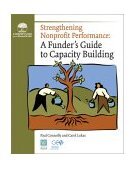Strengthening Nonprofit Performance: A Funder's Guide to Capacity Building
Capacity building — what is it? Why fund it? How does one fund it effectively? Paul Connolly and Carol Lukas answer these questions in Strengthening Nonprofit Performance.
Connolly, senior vice president at the Conservation Company, and Lukas, director of national services for the Wilder Center for Communities at the Amherst H. Wilder Foundation, have extensive experience consulting with nonprofits and funders. The authors define capacity building as "the process of strengthening an organization in order to improve its performance and impact," and this accessible book contains their answers to the many questions funders may have about the complex field.
The first chapter, "Why Invest in Capacity Building," expands on three reasons for investment in capacity building: to enhance program impact, to increase nonprofit and community sustainability, and to leverage philanthropic dollars. The next chapter describes the components of organizational capacity necessary for effective performance, provides brief overviews of types of capacity-building activities, and lists various ways to assist nonprofits.
Chapter three, "How to Build the Capacity of Nonprofits," gets to the heart of the volume. The authors begin by sharing several lessons that funders involved in this work have learned — "Follow others' promising practices" and "Do no harm," to name just two. Next comes a four-step process for establishing or expanding a capacity-building program. Each step (plan to plan, take stock, set direction, and take action and evaluate) also includes a subset of tasks to perform that will inform the decisions the step entails. For example, taking stock involves working through three tasks: determine the organization's readiness and capabilities, review external needs and resources, and acknowledge the organization's values and assumptions. Each of these tasks is then outlined further, and an appendix provides worksheets that aid in completing the tasks. Also included are shortcuts for each of the steps.
Chapter four, "Capacity Building Strategies," builds on a task in the setting-direction step. Connolly and Lukas explain seven different capacity-building strategies a funder may choose, ranging from giving program grants that promote organizational effectiveness to direct management assistance, and provide examples that illustrate each strategy. A table lists the benefits and limitations of the seven strategies. In addition to the task worksheets, the appendices include information on the challenges of international capacity building and a detailed list of resources for more information.
Overall, Strengthening Nonprofit Performance serves as a useful single-volume guide for funders contemplating or expanding a capacity-building program.
For citations to additional materials on this topic, refer to Literature of the Nonprofit Sector Online, using the keywords "capacity building."








